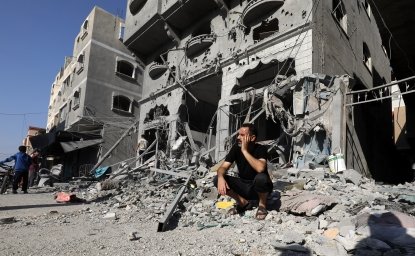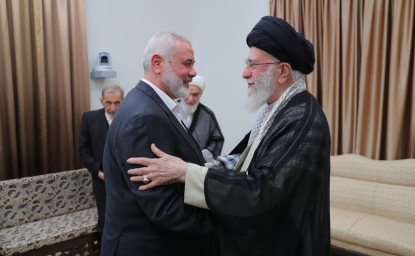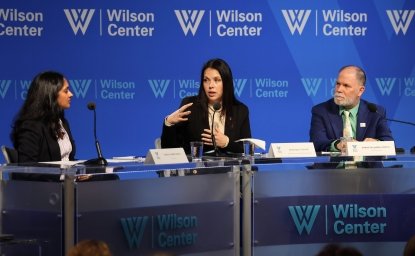On March 8, General Lloyd J. Austin III, told the Senate Armed Services Committee that the United States “is making progress militarily” in the effort to defeat the Islamic State. But the commander of U.S. Central Command also emphasized that “military success will be lasting only if corresponding political progress is achieved in both Iraq and Syria.” The following are excerpts from his prepared statement.
This past year, we worked through a number of tough challenges throughout the Central Region. Five specific areas required a larger share of our energy and attention. Foremost among them is Operation INHERENT RESOLVE in Iraq and Syria. American military action, coupled with our leadership of the 66-member international coalition, has achieved substantial progress in combatting ISIL. We have degraded the organization, which was Phase I of the military campaign, and we are well along in Phase II operations which focus on dismantling ISIL. The forging of a whole-of-government effort has maximized the effectiveness of military and diplomatic actions. At the same time, we are providing support to the Gulf Cooperation Council (GCC)-led Coalition in Yemen. Additionally, we maintain pressure on extremist networks and actively pursue terrorists in the region on a daily basis. Next, we continue to support operations in Afghanistan where we have transitioned to a mission focused on helping the Afghans to build needed capability and fortify their security forces, while we continue to take direct action against Al Qaeda (AQ), ISIL – Khorasan Group (ISIL-KP), and others that present a threat to U.S. and coalition forces. Finally, we keep a close eye on Iran. We are hopeful that the controls put in place as a result of the Joint Comprehensive Plan of Action (JCPOA) agreement will discourage Iran from pursuing a nuclear weapon. Regardless, Iran maintains hegemonic ambitions and will continue to pose a threat to the region through the employment of various antiaccess and area denial (A2/AD) capabilities, theater ballistic missile and cyber capabilities, aggressive maritime activities, and the destabilizing activities of the Iranian Threat Network (ITN) and its Iranian Revolutionary Guard Corps-Qods Forces (IRGC-QF), and other proxies operating in the region.
The command’s primary focus this past year has been the ongoing fight against transnational VEOs, and namely ISIL or what is referred to by many in the region as “Daesh.” While the group’s military capabilities have been degraded in Iraq and Syria, which represents the center of ISIL’s self-proclaimed Caliphate, the group remains a legitimate terrorist threat in both countries and has expanded its reach to other parts of the globe, including Egypt, Afghanistan-Pakistan, Yemen, Libya, West Africa, and parts of the Pacific. ISIL’s presence undermines nation-states while driving competition for leadership among global jihadists. This competition has led to increased activity by ISIL and AQ which, although its capability is degraded, remains relevant and active throughout the region. ISIL’s insidious activities perpetuate sectarian conflict and, if not effectively addressed, could serve to spark a broader regional sectarian war. For these and a host of other reasons, ISIL poses the most immediate security threat to our interests and the interests of our partners and allies. It must be – and it will be – defeated.
Over the past year we have seen a trend emerge as countries have begun to take more seriously the threat from transnational and trans-regional VEOs. Many of our regional partners historically did not prioritize the threat from VEOs. They were less concerned that these organizations would attack them at home. However, ISIL has changed that paradigm. Countries, including Saudi Arabia and Egypt, now are dealing with a very real threat from Sunni extremists that they did not encounter in the past. They recognize that they can no longer afford to dismiss these threats. In the same way, countries outside of the Central Region, particularly throughout Europe and Turkey, have experienced a relatively high number of terrorist attacks conducted by or inspired by VEOs in the region, including ISIL and AQ. As partner nations’ perceptions begin to change, we should seize the opportunity and work with them to build additional needed capability.
The most prevalent challenge facing the Central Region continues to be the “underlying currents” that fuel many of the destructive behaviors that plague that strategically-important part of the world. These currents include a growing ethno-sectarian divide; the ongoing religious struggle between violent extremists and moderates; and, the rejection of corruption and oppressive governance. They also include the “youth bulge,” which consists of young and unemployed or under-employed and disenfranchised individuals who feel marginalized and thus are ripe for recruitment by extremist elements. While there appears to be a greater recognition of the negative effects of these currents, we have yet to see sufficient improvements made to address them. Indeed, they are becoming even more pronounced. In many parts of the region, ethnic and sectarian affiliation has taken on greater importance, moving to the forefront of individuals’ and nation-states’ identities. For example, it is more important for some to be Sunni or Shia, Kurdish or Arab, than to be an Iraqi or a Syrian. Stakeholders recognize this changing dynamic, and they have not only sought to benefit from the growing instability, many actively exploit the sectarian tensions to promote their own goals and objectives. All of this has the effect of seriously weakening the nation states in the region.
Progress with respect to the root causes of the instability can only be achieved by the governments and the people of the region with our continued support. They must actively work to address the growing ethno-sectarian divide, elevate the voice of moderates, root out corruption, guard against freedom of movement and expanding influence by terrorist groups in ungoverned and undergoverned spaces, and ensure the young people of the region have access to better opportunities and are able to contribute to society in meaningful ways. We need to see responsive governments in place and taking an active role in addressing these and other challenges facing the region.
The international community must also do its part to address the radical ideologies that serve to inspire extremist behaviors. It should be noted that the fight against ISIL is not simply a fight against a VEO. ISIL is an ideologically-motivated movement and must be addressed as such if we hope to achieve lasting, positive effects. We are beginning to see some positive trends with an increasing number of state leaders, senior clerics, and religious leaders from Arab countries speaking out against radical extremism. We are hopeful that such ventures will bear fruit, and we will do all that we can to support them going forward.
What should concern us all, beyond the sectarian nature of today’s conflicts, is the growing risk that the increased malign activity by proxy and surrogate actors could lead to perpetual armed conflict and resulting widespread instability in the region. The “underlying currents” are common to many of the problems that exist, and activities in one area often fuel challenges in other parts of the region. We will have to keep a close eye on these and other challenges present throughout our area of responsibility.
Operation INHERENT RESOLVE (Iraq-Syria). We remain intensively focused on the crisis in Iraq and Syria and the ongoing fight against the terrorist organization, ISIL. Our military campaign to defeat ISIL requires that we rely on indigenous forces and that we support and enable their efforts using our precision air operations and by advising and assisting their leadership and training and equipping their ground forces. Eighteen-plus months into the campaign, we are putting increased pressure on ISIL throughout the depth and breadth of the battlespace. We are achieving good effects against the enemy; we completed Phase I of the military campaign (Degrade) and are well into Phase II (Dismantle).
In Iraq, the Iraqi Security Forces, which include Iraqi Army and Counter-Terrorism Services (CTS) forces, Kurdish Peshmerga, and various Sunni and Shia volunteer elements, with the support of U.S. and Coalition air operations and advisors and materiel donations, have effectively halted ISIL’s advance. The enemy is now almost exclusively focused on defending his strongholds rather than projecting combat power. Additionally, ISIL’s counter-attack capability has been reduced as a result of battlefield losses, although we see the group conducting deadly terrorist attacks against Iraqi forces in Anbar and west of Baghdad, and, worryingly, civilian targets – including in areas far from its control, in Baghdad and parts of the Shia-populated south.
In Syria, we are supporting and enabling the efforts of the indigenous forces, including Syrian Kurds, Arabs, Christians, Turkmen, and others. These forces are putting increased pressure on the enemy as they push south towards the capital of ISIL’s self-proclaimed Caliphate in Raqqa. They have retaken more than 18,000 square kilometers of territory and cut a number of ISIL’s key lines of communication (LOC). They also secured key border crossings between Syria and Turkey, impacting ISIL’s ability to send in reinforcements and much-needed re-supply. It is quite possible that the military efforts underway in Syria could progress more rapidly given that we now have a growing number of willing and capable partners on the ground.
Since commencing air operations in early August 2014, Coalition air crews from 19 partner nations have conducted more than 10,700 strikes. They are taking the fight to the enemy, and have greatly enabled the reach and effectiveness of the indigenous ground forces. Coalition airstrikes have removed several thousand enemy fighters from the battlefield, to include more than 160 of ISIL’s leaders. We have destroyed thousands of the enemy’s vehicles, tanks, and heavy weapon systems, along with training sites and storages facilities, command and control structures, and oil production facilities. We have helped to retake more than 40% of the territory in Iraq that ISIL held when we began airstrikes in August 2014, and we have restricted the enemy’s freedom of movement along key routes in both Iraq and Syria. We have expanded our targeting of ISIL’s oil enterprise, one of his primary sources of revenue and destroyed several bulk cash storage sites. This is further restricting ISIL’s access to critical funds and other resources. This enemy hides among the civilian population; and so, we must be as precise as possible to avoid causing unnecessary civilian casualties and destruction of critical infrastructure, thereby generating resentment among the local populace. The high level of precision achieved by our air crews has ensured minimal collateral damage.
The situation in Iraq and Syria is made even more complex by the involvement of external actors, specifically Russia and Iran. It is apparent through Russia’s actions that their primary objective in Syria is to bolster the Assad Regime, principally by targeting those Syrian moderate opposition forces that pose a threat to the Regime. Through its actions, Russia is effectively prolonging the civil war in Syria, which over the past five years has caused the deaths of well over 250,000 innocent men, women, and children. Assad would almost certainly not be in power today were it not for the robust support provided to the Regime by Iran and Russia. Russia’s involvement in Syria exacerbates sectarian tensions as it appears they are supporting the Shiite states against the Sunnis. By putting the full range of their military capability on display in Syria, the Russians hope to impress regional actors and assert global power. Ultimately, they want to enhance their regional influence to counter the U.S. as the indispensable power player in the Middle East. None of Russia’s military actions have helped stabilize Syria or end the suffering of the Syrian people. The recent Cessation of Hostilities process is an opportunity for Russia to demonstrate a renewed commitment to play a constructive role in Syria. We will continue to judge Russia by its actions, not by its words.
Of note, Russia’s cooperation with Iran appears to be expanding beyond near-term coordination for operations in Syria and is moving towards an emerging strategic partnership. The potential for a more traditional security cooperation arrangement between Russia, a state actor and member of the UN Security Council, and Iran is cause for significant concern given Iran’s existing relationship with the Syrian Regime and Lebanese Hezbollah. We already see indications of high-end weapon sales and economic cooperation between the two countries.
We are making progress militarily in our efforts to defeat ISIL, as demonstrated by the recent victories in Ramadi and Shaddadi. However, military success will be lasting only if corresponding political progress is achieved in both Iraq and Syria. The Government of Iraq must take the necessary steps towards greater inclusiveness. Iraq will not remain a unified state long-term without the support of the major ethno-sectarian groups. In Syria, President Bashar al-Assad’s actions and his deplorable treatment of the Syrian people created enormous instability in the country that allowed ISIL to flourish. ISIL will remain difficult to defeat as long as Assad remains in power. He needs to be replaced and a stable, responsive government must be established to prevent safe haven for VEOs like ISIL.
To defeat ISIL we must do as President Obama said and “squeeze its heart [in order to] make it harder for ISIL to pump its terror and propaganda through the rest of the world.” This remains the foundation of our Military Campaign Plan – to degrade, dismantle, and eventually defeat this enemy in Iraq and Syria. This is essential; however, it is not sufficient. Beyond its strongholds in Iraq and Syria, ISIL has expanded to other parts of the globe, including to Egypt, Saudi Arabia, Libya, Yemen, and Afghanistan-Pakistan. Expansion is a necessary element of ISIL’s declared end-state of a global Caliphate. It also demonstrates that we are degrading the enemy’s capability in Iraq and Syria; as a result, ISIL is attempting to gain a foothold in alternate locations. Moreover, the increased activity helps to distract the international community from the setbacks that ISIL is experiencing in Iraq and Syria. To maintain its legitimacy, ISIL must achieve real or perceived military victories and it must expand territorially. While the priority must be the defeat of ISIL’s core in Iraq and Syria, we also will need to address the ISIL affiliates and franchises that exist in other parts of the region and globe. Additionally, we will need to continue in our efforts to curb the flow of foreign fighters, and take away the enemy’s ability to resource himself.
The U.S. military is not doing any of this alone. The military campaign is just one component of the broader U.S. Government (USG) strategy which consists of nine lines of effort (LOE), to be executed by all elements of the USG with the support of our coalition partners. The military is responsible for two of the nine LOEs, LOE #2 and #3. LOE #2 – “Denying ISIL Safe Haven” is being accomplished through our support to indigenous ground forces in Iraq and Syria, primarily through our precision airstrikes, employment of available Intelligence, Surveillance, and Reconnaissance (ISR) assets, and our advise and assist efforts. LOE #3 – “Building Partner Capacity” includes our train and equip program and advise and assist efforts in Iraq. Critically important are the many contributions being made by the 66 partners that make up the Counter-ISIL Coalition; the Coalition represents the strength of the military campaign. We made it clear at the outset of the campaign that the defeat of ISIL would take time. There is tough work still ahead. We must remain vigilant and keep pressure on this enemy, recognizing the high stakes involved.
Countering Terrorism and Violent Extremist Organizations. A variety of factors that include poor governance, economic disparity, disenfranchised populaces, and deficient security forces contribute to creating conditions that promote the activities of VEOs, including ISIL and AQ. The VEOs are able to plan and launch attacks, undermine local governments, and exercise malign influence from ungoverned or under-governed spaces. In doing so, they threaten regional security and U.S. core national interests, including the defense of our homeland.
Perhaps the most significant development in recent years is the proliferation of transnational and trans-regional VEOs that desire and, in some cases, demonstrate the ability to shape and even dominate the security environment in ways that we have not seen before. These transnational extremist groups are ideologically opposed to and often target the nation states in the region. They conduct attacks and terrorize local populaces in an effort to undermine and eventually topple existing governments. This further contributes to increased instability in the region.
One related dynamic that we see developing is a growing competition between transnational extremist groups. For a long period of time, AQ was the unchallenged leader of global jihad. Then, in late spring of 2014, ISIL seized large swaths of territory in Iraq, in addition to the territory it seized in Syria. It declared a Caliphate and suddenly AQ was facing a rival. Going forward, there is significant potential for increased expansion among VEOs as ISIL and AQ compete for resources and recruits. This will compel both groups to conduct more spectacular operations and to employ more aggressive messaging campaigns. As ISIL and AQ look to expand their influence, we can expect other VEOs to attempt to align with these groups. The resulting struggle and heightened activity will contribute to increasing instability across the region.
We must take direct military action where appropriate to counter this growing threat. We cannot allow VEOs to operate uncontested in the region, permitting them to grow stronger and expand their global reach. The long-term defeat of VEOs will require that our regional partners provide for the security of their sovereign spaces, with the U.S. and its allies providing support where possible. Until they have sufficient capability to do so, we must be prepared to take active direct measures to counter these VEOs.
Click here to read the full statement

The Islamists
Learn more about Hamas and how it relates to similarly aligned organizations throughout the region. Read more

Explore More
Browse Insights & Analysis
Israel Escalates Attacks in Gaza: What’s Next?

Israel Expands Operations on Multiple Fronts: Perspectives on the Conflict

